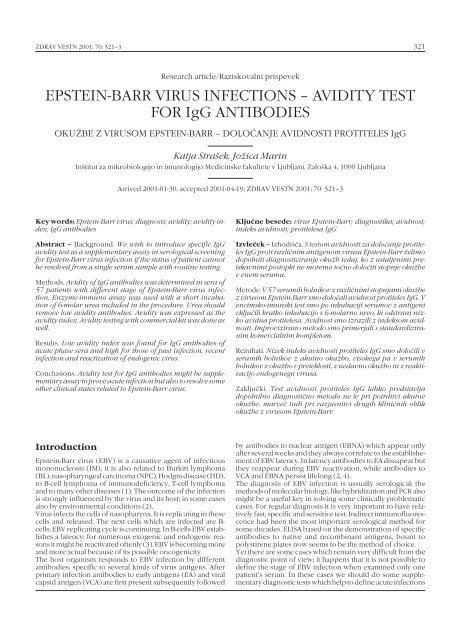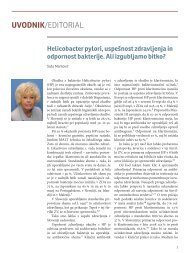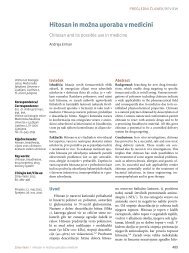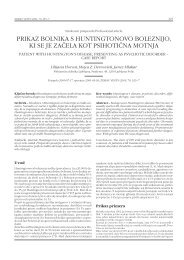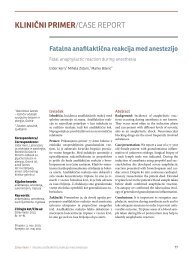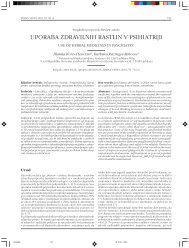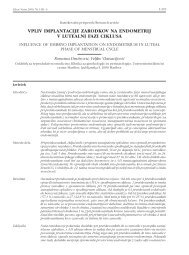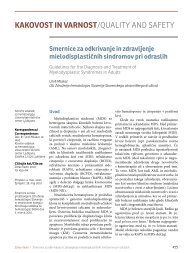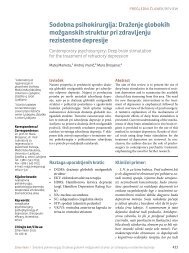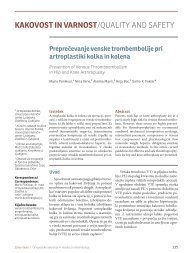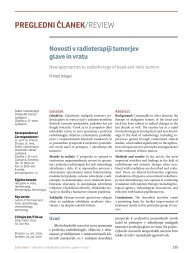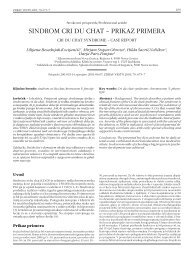AVIDITY TEST FOR IgG ANTIBODIES
AVIDITY TEST FOR IgG ANTIBODIES
AVIDITY TEST FOR IgG ANTIBODIES
Create successful ePaper yourself
Turn your PDF publications into a flip-book with our unique Google optimized e-Paper software.
ZDRAV VESTN 2001; 70: 321–3<br />
321<br />
Research article/Raziskovalni prispevek<br />
EPSTEIN-BARR VIRUS INFECTIONS – <strong>AVIDITY</strong> <strong>TEST</strong><br />
<strong>FOR</strong> <strong>IgG</strong> <strong>ANTIBODIES</strong><br />
OKUŽBE Z VIRUSOM EPSTEIN-BARR – DOLOČANJE AVIDNOSTI PROTITELES <strong>IgG</strong><br />
Katja Strašek, Jožica Marin<br />
Inštitut za mikrobiologijo in imunologijo Medicinske fakultete v Ljubljani, Zaloška 4, 1000 Ljubljana<br />
Arrived 2001-01-30, accepted 2001-04-19; ZDRAV VESTN 2001; 70: 321–3<br />
Key words: Epstein-Barr virus; diagnosis; avidity; avidity index;<br />
<strong>IgG</strong> antibodies<br />
Abstract – Background. We wish to introduce specific <strong>IgG</strong><br />
avidity test as a supplementary assay in serological screening<br />
for Epstein-Barr virus infection if the status of patient cannot<br />
be resolved from a single serum sample with routine testing.<br />
Methods. Avidity of <strong>IgG</strong> antibodies was determined in sera of<br />
57 patients with different stage of Epstein-Barr virus infection.<br />
Enzyme-immuno assay was used with a short incubation<br />
of 6-molar urea included in the procedure. Urea should<br />
remove low avidity antibodies. Avidity was expressed as the<br />
avidity index. Avidity testing with commercial kit was done as<br />
well.<br />
Results. Low avidity index was found for <strong>IgG</strong> antibodies of<br />
acute phase sera and high for those of past infection, recent<br />
infection and reactivation of endogenic virus.<br />
Conclusions. Avidity test for <strong>IgG</strong> antibodies might be supplementary<br />
assay to prove acute infection but also to resolve some<br />
other clinical states related to Epstein-Barr virus.<br />
Ključne besede: virus Epstein-Barr; diagnostika; avidnost;<br />
indeks avidnosti; protitelesa <strong>IgG</strong><br />
Izvleček – Izhodišča. S testom avidnosti za določanje protiteles<br />
<strong>IgG</strong> proti različnim antigenom virusa Epstein-Barr želimo<br />
dopolniti diagnosticiranje okužb tedaj, ko z ustaljenimi preiskavnimi<br />
postopki ne moremo točno določiti stopnje okužbe<br />
v enem serumu.<br />
Metode. V 57 serumih bolnikov z različnimi stopnjami okužbe<br />
z virusom Epstein-Barr smo določali avidnost protiteles <strong>IgG</strong>. V<br />
encimsko-imunski test smo po inkubaciji serumov z antigeni<br />
vključili kratko inkubacijo s 6-molarno ureo, ki odstrani nizko<br />
avidna protitelesa. Avidnost smo izrazili z indeksom avidnosti.<br />
Improvizirano metodo smo primerjali s standardiziranim<br />
komercialnim kompletom.<br />
Rezultati. Nizek indeks avidnosti protiteles <strong>IgG</strong> smo določili v<br />
serumih bolnikov z akutno okužbo, visokega pa v serumih<br />
bolnikov z okužbo v preteklosti, z nedavno okužbo in z reaktivacijo<br />
endogenega virusa.<br />
Zaključki. Test avidnosti protiteles <strong>IgG</strong> lahko predstavlja<br />
dopolnilno diagnostično metodo ne le pri potrditvi akutne<br />
okužbe, marveč tudi pri razjasnitvi drugih kliničnih oblik<br />
okužbe z virusom Epstein-Barr.<br />
Introduction<br />
Epstein-Barr virus (EBV) is a causative agent of infectious<br />
mononucleosis (IM); it is also related to Burkitt lymphoma<br />
(BL), nasopharyngeal carcinoma (NPC), Hodgin disease (HD),<br />
to B-cell lymphoma of immunodeficiency, T-cell lymphoma<br />
and to many other diseases (1). The outcome of the infection<br />
is strongly influenced by the virus and its host; in some cases<br />
also by environmental conditions (2).<br />
Virus infects the cells of nasopharynx. It is replicating in these<br />
cells and released. The next cells which are infected are B-<br />
cells; EBV replicating cycle is continuing. In B-cells EBV establishes<br />
a latency; for numerous exogenic and endogenic reasons<br />
it might be reactivated oftenly (3). EBV is becoming more<br />
and more actual because of its possible oncogenicity.<br />
The host organism responds to EBV infection by different<br />
antibodies, specific to several kinds of virus antigens. After<br />
primary infection antibodies to early antigens (EA) and viral<br />
capsid antigen (VCA) are first present subsequently followed<br />
by antibodies to nuclear antigen (EBNA) which appear only<br />
after several weeks and they always correlate to the establishement<br />
of EBV latency. In latency antibodies to EA dissapear but<br />
they reappear during EBV reactivation, while antibodies to<br />
VCA and EBNA persist lifelong (2, 4).<br />
The diagnosis of EBV infection is ussually serological; the<br />
methods of molecular biology, like hybridization and PCR also<br />
might be a useful key in solving some clinically problematic<br />
cases. For regular diagnosis it is very important to have relatively<br />
fast, specific and sensitive test. Indirect immunofluorescence<br />
had been the most important serological method for<br />
some decades. ELISA based on the demonstration of specific<br />
antibodies to native and recombinant antigens, bount to<br />
polystirene plates now seems to be the method of choice.<br />
Yet there are some cases which remain very difficult from the<br />
diagnostic point of view; it happens that it is not possible to<br />
define the stage of EBV infection when examined only one<br />
patient’s serum. In these cases we should do some supplementary<br />
diagnostic tests which help to define acute infections
322 ZDRAV VESTN 2001; 70<br />
or other stages of infection. One of these tests could be the<br />
avidity test of specific <strong>IgG</strong> antibodies or Western blot.<br />
Avidity tells about the strength of antibodies’ binding to multivalent<br />
antigen. Avidity can be measured after short incubation<br />
of the antigen-antibody complex with 6 M urea (5). High<br />
avidity antibodies persist in binding to the antigen, while low<br />
avidity antibodies are destroyed after the addition of urea.<br />
In this study we’ve measured the avidity of <strong>IgG</strong> antibodies<br />
(anti-EA, anti-VCA, anti-EBNA) in sera of patients previously<br />
examined by ELISA to define their immune status to EBV.<br />
The results of »in house« avidity test were compared to the<br />
results obtained by commercially available test kit, oriented to<br />
measure avidity of <strong>IgG</strong> anti-EBV.<br />
Material and methods<br />
Sera of patients. In this study 74 sera of patients previously<br />
examined for EBV immune status (4, 7) were included for<br />
measuring <strong>IgG</strong> antibodies’ avidity. According to their anti-EBV<br />
status sera were divided into four groups: patients’ sera with<br />
acute EBV infection (n = 22), recent infection (n = 18), past<br />
infection (n = 11) and with virus reactivation (n = 23).<br />
»In house« avidity test. All sera were repetedly tested by ELISA.<br />
After the incubation of sera with specific antigens, the plates<br />
were washed; in each well 100 µl of 6 M urea was added for 3<br />
mins at room temperature. Urea was removed, the plates were<br />
washed again and ELISA was continued as described elsewhere<br />
(5, 7).<br />
Avidity test with commercial kit – Enzygnost Anti-EBV <strong>IgG</strong>;<br />
Avidity Reagent for Enzygnost (Dade Behring, Marburg, Germany).<br />
This test was performed following instructions of the<br />
manufacturer (8).<br />
Measurement of avidity. Avidity of <strong>IgG</strong> antibodies is expressed<br />
by the avidity index (AI). In »in house« avidity test AI was obtained<br />
when optical density (OD) of the sample, treated with<br />
urea, was devided by OD of the same sample which was not<br />
treated with urea. When AI is 0.50–1.00, it means high avidity<br />
of <strong>IgG</strong> antibodies and this is characteristic for past infection.<br />
When AI is < 0.25, it means low avidity of <strong>IgG</strong> antibodies and<br />
this reflects acute infection. AI values of 0.25–0.50 are equivocal<br />
(5).<br />
By the use of commercial test kit, AI was determined in the<br />
same way as in »in house« avidity test; the only difference was<br />
that the quocient was multiplied by 100. So AI was expressed<br />
in percentages. Cut off value was 40% (8).<br />
Statistics. The results were statistically evaluated in different<br />
EBV infections by χ 2 test.<br />
Results<br />
»In house« avidity test<br />
Avidity of <strong>IgG</strong> anti-EA. <strong>IgG</strong> anti-EA were present in 31 sera<br />
tested: 18 sera belonged to patients with acute infection, 13 to<br />
patients with recent infection. In 6 sera of patients with acute<br />
infection OD fell under the cut off value after the treatment<br />
with urea. In 2 sera of patients with recent infection antibodies<br />
were destroyed after the treatment with urea. Average<br />
values of AI in acute and recent infection are presented in<br />
Figure 1. The differences are statistically significant (p = 0.05).<br />
Avidity of <strong>IgG</strong> anti-EBNA. <strong>IgG</strong> anti-EBNA were determined in<br />
sera of 25 patients: in 17 of them with virus reactivation, in 8<br />
with recent infection. After the treatment with urea in 8 sera<br />
of patients with reactivated virus a minor fall of OD was<br />
found. The same results were observed in the group of patients<br />
with recent infection. Average AI values in both groups<br />
were high (Fig. 2). The differences were not statistically significant.<br />
Avidity index (average values)<br />
Povpreèni indeks avidnosti<br />
1,2<br />
1,0<br />
0,8<br />
0,6<br />
0,4<br />
0,2<br />
0,0<br />
Acute / Akutna<br />
Recent / Nedavna<br />
Stage of infection / Stopnja okužbe<br />
Fig. 1. Graphical presentation of avidity index for <strong>IgG</strong> anti-EA.<br />
Sl. 1. Grafični prikaz indeksa avidnosti <strong>IgG</strong> anti-EA.<br />
Avidity index (average values)<br />
Povpreèni indeks avidnosti<br />
1,2<br />
1,0<br />
0,8<br />
0,6<br />
0,4<br />
0,2<br />
0,0<br />
Recent / Nedavna<br />
Virus reactivation /<br />
Reaktivacija virusa<br />
Stage of infection / Stopnja okužbe<br />
Fig. 2. Graphical presentation of avidity index for <strong>IgG</strong> anti-<br />
EBNA.<br />
Sl. 2. Grafični prikaz indeksa avidnosti <strong>IgG</strong> anti-EBNA.<br />
Avidity of <strong>IgG</strong> anti-VCA. <strong>IgG</strong> anti-VCA were determined in sera<br />
of 18 patients; 4 of them with acute infection, 4 with the past<br />
infection, 5 with recent infection and 5 of them experienced<br />
the virus reactivation. In all sera the fall of OD values were<br />
found after the treatment with urea. Average AI values were<br />
borderline or higher (Fig. 3). The differences were statistically<br />
significant only between patients with acute and recent infection<br />
(p = 0.05).<br />
Commercial test kit<br />
Avidity of <strong>IgG</strong> anti-EBV. <strong>IgG</strong> anti-EBV were found in sera of 17<br />
patients: 7 of them had past infection, 4 patients had reactivated<br />
virus, in 3 patients acute infection was determinated and<br />
in 3 patients recent infection. In sera of patients with acute<br />
infection the evident fall of OD values were found after the<br />
treatment with »avidity reagent«. Average AI values were low<br />
in this group as well. In other groups of sera AI was high (Fig.<br />
4). Statistically significant differences were found between sera<br />
of patients with acute and past infection and also between<br />
acute infection and reactivated virus (p = 0.05). The differences<br />
in AI between sera with acute and recent infection were<br />
not significant.
STRAŠEK K, MARIN J. EPSTEIN-BARR VIRUS INFECTIONS – <strong>AVIDITY</strong> <strong>TEST</strong> <strong>FOR</strong> <strong>IgG</strong> <strong>ANTIBODIES</strong><br />
323<br />
Avidity index (average values)<br />
Povpreèni indeks avidnosti<br />
0,6<br />
0,5<br />
0,4<br />
0,3<br />
0,2<br />
0,1<br />
0,0<br />
80<br />
70<br />
60<br />
50<br />
40<br />
30<br />
20<br />
10<br />
0<br />
Specificity and sensitivity of the avidity test<br />
The specificity of our test was 59.38% and the sensitivity 91.67%.<br />
Discussion<br />
Acute<br />
Akutna<br />
Recent<br />
Nedavna<br />
Virus reactivation<br />
Reaktivacija virusa<br />
Stage of infection / Stopnja okužbe<br />
Past<br />
Pretekla<br />
Fig. 3. Graphical presentation of avidity index of <strong>IgG</strong> anti-<br />
VCA.<br />
Sl. 3. Grafični prikaz indeksa avidnosti <strong>IgG</strong> anti-VCA.<br />
Avidity index (average values)<br />
Povpreèni indeks avidnosti<br />
Acute<br />
Akutna<br />
Recent<br />
Nedavna<br />
Past<br />
Pretekla<br />
Stage of infection / Stopnja okužbe<br />
Virus reactivation<br />
Reaktivacija virusa<br />
Fig. 4. Graphical presentation of avidity index of <strong>IgG</strong> anti-<br />
EBV.<br />
Sl. 4. Grafični prikaz indeksa avidnosti <strong>IgG</strong> anti-EBV.<br />
The measurement of <strong>IgG</strong> anti-EBV avidity might be a supplementary<br />
diagnostic procedure in the situation of problematic<br />
clinical cases, when we are not able to define precisely the<br />
stage of EBV infection (8, 9). Normally, we do diagnosis of<br />
EBV infection by ELISA; sometimes the result is not in good<br />
correlation to the clinical state of the patient – in most cases<br />
these are adult patients with laboratory determined recent<br />
infection. This is, according to the known EBV epidemiological<br />
situation in our population, quite unusual. We suppose<br />
that these patients in fact do not experience recent infection,<br />
but they might have just gone through EBV reactivation: IgM<br />
anti-EA have dissapeared, the patients still have <strong>IgG</strong> anti-EA<br />
and of course they have permanently present <strong>IgG</strong> anti-EBNA.<br />
This patients were a perfect challange for us to introduce »in<br />
house« avidity test, which has found that both patients with<br />
»recent« infection and patients with EBV reactivation had <strong>IgG</strong><br />
antibodies with high avidity; but as a rule, in recent infection<br />
<strong>IgG</strong> antibodies should have low avidity. In this study only adult<br />
patients were included and so it remains to compare <strong>IgG</strong> avidity<br />
of children with laboratory diagnosed recent infection.<br />
Preliminary we presume that the avidity of <strong>IgG</strong> (anti-EA, anti-<br />
VCA and eventually anti-EBNA) should be low.<br />
Avidity test we have used in the study was not standardized.<br />
This is also the reason why the differences in optical density<br />
of »normal« sera and of sera treated with urea were not as clear<br />
as we had expected. The same problem was mentioned by<br />
Weissbrich (6). This author advises to use immunofluorescence<br />
when avidity is to be measured. So we here tested a<br />
minor number of sera with anticomplement immunofluorescence.<br />
To measure avidity, the treatment with urea was included<br />
in the test as well. The results incouraged us and we<br />
agree with Weissbrich, that the results of avidity in immunofluorescence<br />
are more easy to interpret than with ELISA.<br />
At the end of the study the commercial avidity test was offered<br />
to us and we were able to test some sera. We believe that this<br />
test kit will be really very helpful in EBV diagnosis. By the use<br />
of this kit the avidity of all <strong>IgG</strong> antibodies are determined; the<br />
results our study point to the avidity of specific <strong>IgG</strong> and this is<br />
our scientific contribution to general knowledge of avidity.<br />
The main privilege of the commercial test kit is that the difference<br />
between acute and all the other stages of EBV infections<br />
is clearly evident – far more clear than with the »in house«<br />
avidity test.<br />
Aknowledgements<br />
We thank to Mrs. Katja Sluga and Snežana Kramar for their<br />
excellent technical assistence.<br />
Literatura<br />
1. Rickinson AB, Kieff E. Epstein-Barr virus. In: Fields BN, Knipe PM, Howley<br />
PM et al. eds. Fields virology. 3 th ed. Philadelphia: Lippincot, Raven Publishers,<br />
1996: 2397–446.<br />
2. Okano M. Epstein-Barr virus infection and its role in the expanding spectrum<br />
of human diseases. Acta Paediatr 1998; 87: 11–8.<br />
3. Faulkner GC, Krajewski AS, Crawford DH. The ins and outs of EBV infections.<br />
Trends in Microbiol 2000; 8: 185–9.<br />
4. Marin J. Dokazovanje okužb, ki jih povzroča virus Epstein-Barr; encimsko<br />
imunski test namesto posredne imunofluorescence. Zdrav Vestn 1995; 64:<br />
13–4.<br />
5. Anderson A, Vetter V, Kreutzer L, Bauer G. Avidities of <strong>IgG</strong> directed against<br />
viral capsid antigen or early antigen: useful markers for significant Epstein-<br />
Barr virus serology. J Med Virol 1994; 43: 238–44.<br />
6. Weissbrich B. The use of semi-automated EBV <strong>IgG</strong> avidity determination for<br />
the diagnosis of infectious mononucleosis. J Med Virol 1998; 54: 145–53.<br />
7. Strašek K. Diagnostika okužb z virusom Epstein-Barr – ugotavljanje avidnosti<br />
<strong>IgG</strong> protiteles. Diplomska naloga. Univerza v Ljubljani, Biotehniška<br />
fakulteta, Enota medoddelčnega študija mikrobiologije 2000: 1–61.<br />
8. Schubert J, Zens W, Weissbrich B. Comparative evaluation of the use of<br />
immunoblots and of <strong>IgG</strong> avidity assays as confirmatory tests for the diagnosis<br />
of acute EBV infections. J Clin Virol 1998; 11: 161–72.<br />
9. Gray JJ. Avidity of EBV VCA-specific <strong>IgG</strong> antibodies: distinction between<br />
recent primary infection, past infection and reactivation. J Virol Methods<br />
1995; 52: 95–104.


